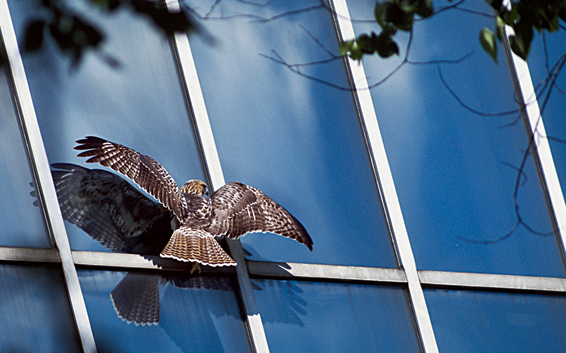
Photo: Deborah Allen, via National Wildlife Federation
It’s spring and time for annual bird migrations, but for the more than 70 percent of U.S. birds, which are migratory, it is increasingly dangerous. A new study published last week in Frontiers in Ecology and the Environment is shedding “light” on the problem that light pollution poses for the vast majority of U.S. migratory birds because they travel at night when they are much more likely to crash into buildings, according to the Cornell Lab of Ornithology, which led the study. They determined that the top five most dangerous cities in the U.S. in the spring are Chicago, Dallas, Houston, Los Angeles, and St. Louis. Ecowatch published the full list of hazardous cities here.
- The researchers looked at both spring and fall migrations and created two lists of cities that pose the greatest risk to birds during the two migratory seasons, based on both geography and light pollution, according to National Public Radio.
- More than 250 different types of birds migrate through Chicago, for a total of 5 million birds total during each migration period.
- It’s not just tall buildings that are dangerous. The Fish &Wildlife Service says that actually, “56 percent of mortality occurs at low-rise (i.e., one to three story) buildings, 44 percent at residences, and less than 1 percent at high rises.”
- Audubon claims that bird fatalities are also caused by the amount of energy the birds waste flying around and calling out in confusion because that exhausts them and makes them vulnerable to other urban threats.
How does this happen, you ask? A second study, this one by researchers at the University of Michigan, also published last week honed in one explanation. The researchers found that songbirds that produce faint chirps during their night migrations collide with lit buildings more often than other species that don’t produce the chirps because they are disoriented by the artificial light, so they send out flight calls and these calls luring other birds to their inevitable death. There are solutions — for example, the National Audubon Society has a “Lights Out” campaign and partners with Audubon local chapters to encourage people to turn off their lights from 11 p.m. to dawn during migration periods.
Why This Matters: The more we know, the better job we can do in minimizing the risks to birds. “Now that we know where and when the largest numbers of migratory birds pass heavily lit areas, we can use this to help spur extra conservation efforts in these cities,” a study co-author said. Exactly.
What You Can Do: If you live in or near one of the dangerous cities, check out these resources from the U.S. Fish & Wildlife Service on how to lower the risks to birds that you can control. Bottom line – turn off your outside lights at night whenever you can!
April 9, 2019 » #LightsOut, Audubon, birds, Fish & Wildlife Service, light pollution, migratory birds, National Audubon Society


